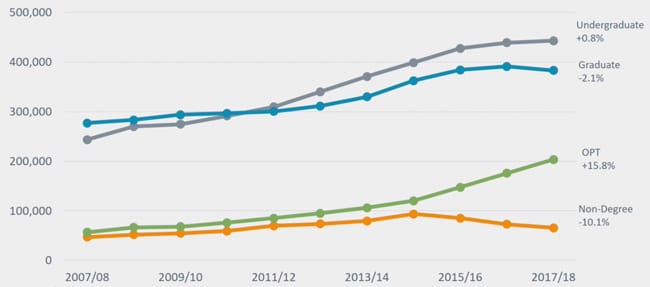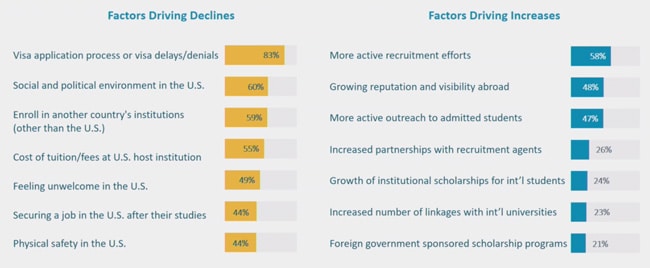International student numbers reach new record in the US but commencements down again this year
For the 12th consecutive year, international student numbers in the US have increased, according to the latest Open Doors Report on International Educational Exchange from the Institute of International Education (IIE). There were 1.5% more international students in the US in the 2017/18 academic year than in 2016/17 for a total enrolment of 1,094,790. While this is an overall increase, it is the smallest increase since 2005/06, not the least because new international student enrolments fell by 6.6% between 2016/17 and 2017/18. The report’s findings were presented by IIE and the US Department of State’s Bureau of Educational and Cultural Affairs (ECA) earlier today. IIE Senior Adviser for Research and Strategy Rajika Bhandari presents the Open Doors 2018 findings at a 13 November briefing.
OPT participation is up
The growth in international student numbers for 2017/18 is mostly due to an increase in the number of international students participating in Optional Practical Training (OPT), the programme that allows international students to remain in the US for 12 months during or after their studies to gain career-related experience (or up to 36 months for students in STEM-related programmes). OPT participants’ numbers rose by 15.8% from 175,695 last year to 203,460 this year. This follows a 20% increase in OPT numbers the previous year.
Programme enrolments dropping
Leaving aside OPT numbers, there has been a decrease in the number of international students on American university and college campuses since 2016/17. Total programme enrolments fell from 903,125 to 891,330 in 2017/18, a -1.3% drop and the first time there has been a reduction in this top-line value in more than a decade. By contrast, just three years ago (2014/15), total international enrolments in programmes of study had grown by 9.5% year-over-year.


Places of origin
Chinese students compose one third of US international enrolments and their numbers grew modestly this year: +3.6% in 2017/18 to 363,340 students compared to 6.8% growth in the previous year. Indian students make up close to a fifth (18%, or 196,270), and their numbers are up by 5.4% over last year; this compares to a 12.3% increase in 2016/17. Significant source countries sending notably more students include Brazil (up 11.7% to 14,620 after a serious tumble last year of -32.4%), Nepal (up 14.3% to 13,270), Pakistan (up 7.4% to 7,535), Nigeria (up 8.4% to 12,695), and especially Vietnam (up 8.4% to 24,325 and higher than last year’s growth of 4.8%). Notable drags on total enrolments came from negative growth in the following major sending markets: Mexico sent 8.1% fewer students (15,470), following a more or less stable trend last year; Canada sent 4.3% fewer students (25,910), also from a stable position last year; South Korea sent 7% fewer (54,555), following a 3.8% drop last year; and Saudi Arabia fell by 15.5% to 44,430, following a 14.2% drop last year.
Most students are self-funded and in STEM fields
More than half of students (58.6%) are self-funded, while about one-sixth receive scholarships/financial aid from US colleges or universities. Engineering (21.3%), business/management programmes (18%), and math/computer science programmes (17%) together enrol more than half of all international students in the US. Math/computer science programmes have experienced notable growth of 11.5% over the previous year. Meanwhile, intensive English programmes have fallen off by close to 15%.
A major economic impact
Even with the flattening enrolment outlook over the last two years, the US remains far and away the world’s leading study destination. International students contributed US$42.4 billion to the American economy in 2017 through tuition, accommodation and living expenses, and other expenses, according to the US Department of Commerce, up from the total of US$39 billion in 2016. Marie Royce, Assistant Secretary of State for Educational and Cultural Affairs, reaffirmed the government’s position on international education in the press release for the Open Doors report:
“International students studying alongside Americans are a tremendous asset to the United States. We need to develop leaders in all fields who can take on our toughest challenges. We need people who can find solutions that keep us secure and make us more prosperous. We want to send a message that international education makes us stronger as a country.”
OPT reforms could curb growth
Optional Practical Training (OPT) is a major recruitment lever in the US as well as a source of skilled international graduates for the US economy – and more than half of OPT participants are working in STEM fields, a major area of innovation and scientific breakthroughs. However, the US Department of Homeland Security (DHS) has signalled in recent months that it may introduce significant changes to the OPT programme. In its agenda for 2018, DHS announced:
“[Immigration and Customs Enforcement] will propose this rule to improve protections of US workers who may be negatively impacted by employment of nonimmigrant students on F and M visas. The rule is a comprehensive reform of practical training options intended to reduce fraud and abuse.”
These reforms have not yet been officially proposed and remain at the “agenda” level of consideration. Reducing the scale and/or benefits of the OPT programme for international students could have a significant impact on overall international student numbers, not the least because nearly half of those participating in OPT are from China and India alone, the two countries that make up nearly half of all international students in the US. For additional background, please see:
- “US admissions directors concerned about international enrolment”
- “Record-high foreign enrolment in US but commencements decline for the first time in 12 years”
- “Up and down the table: Growth trends across major international study destinations”
- “Scale of OPT growth revealed as US administration contemplates reforms”
















